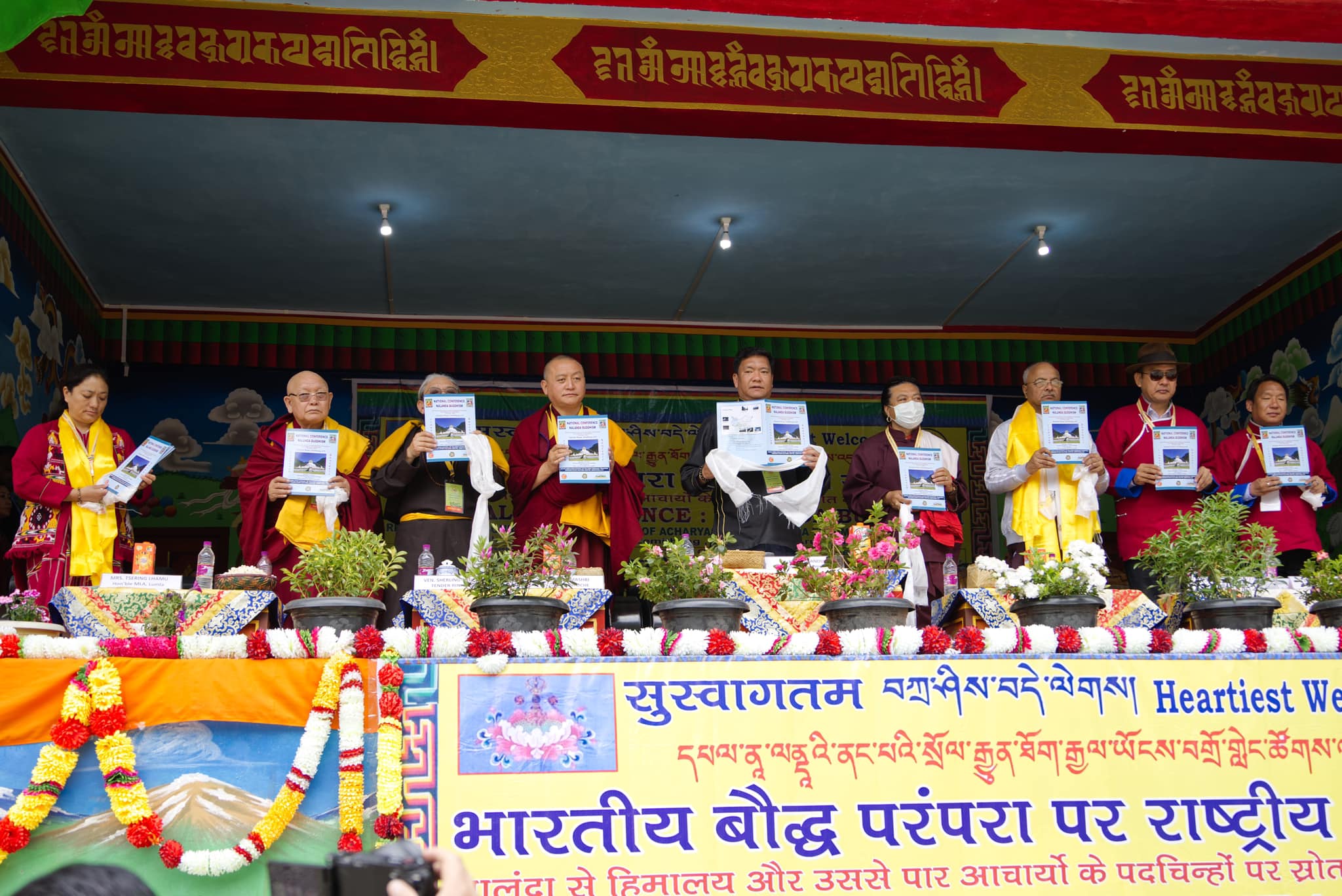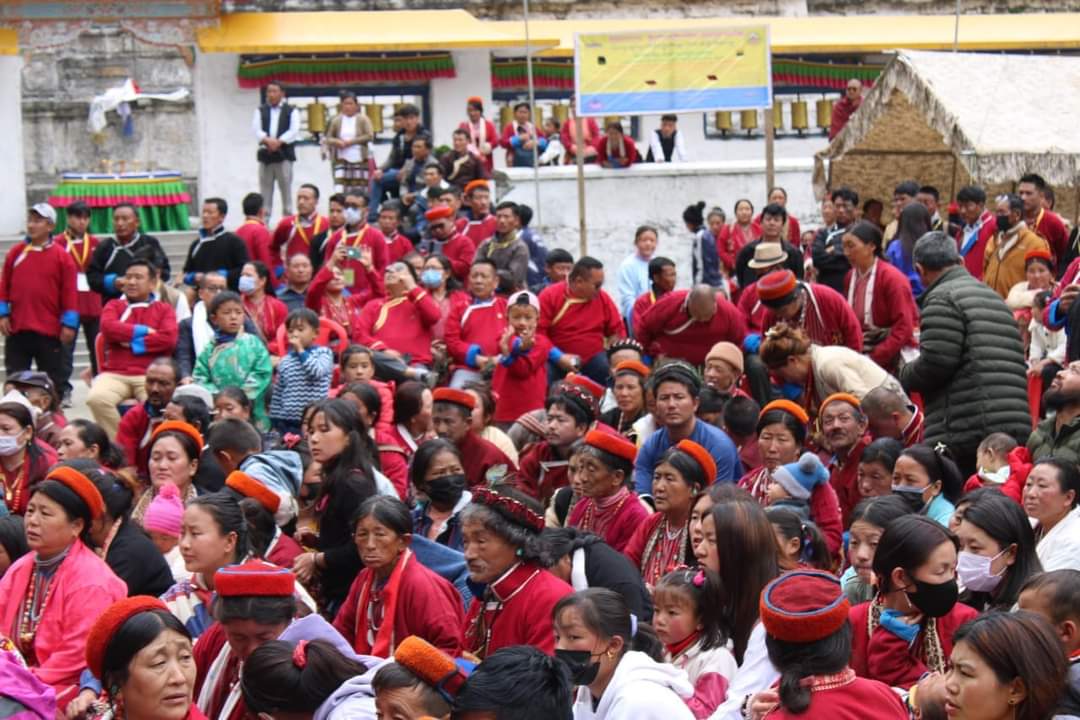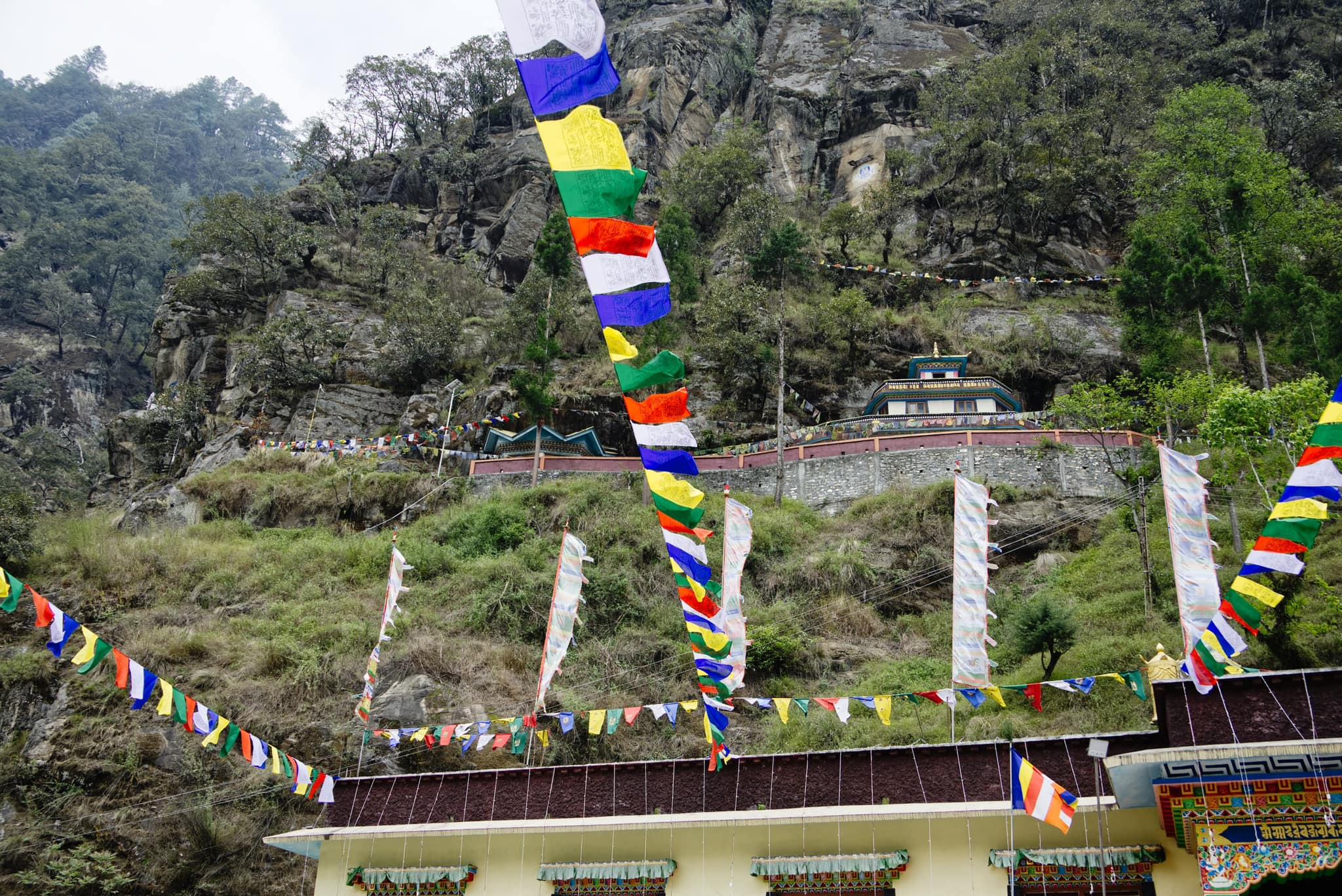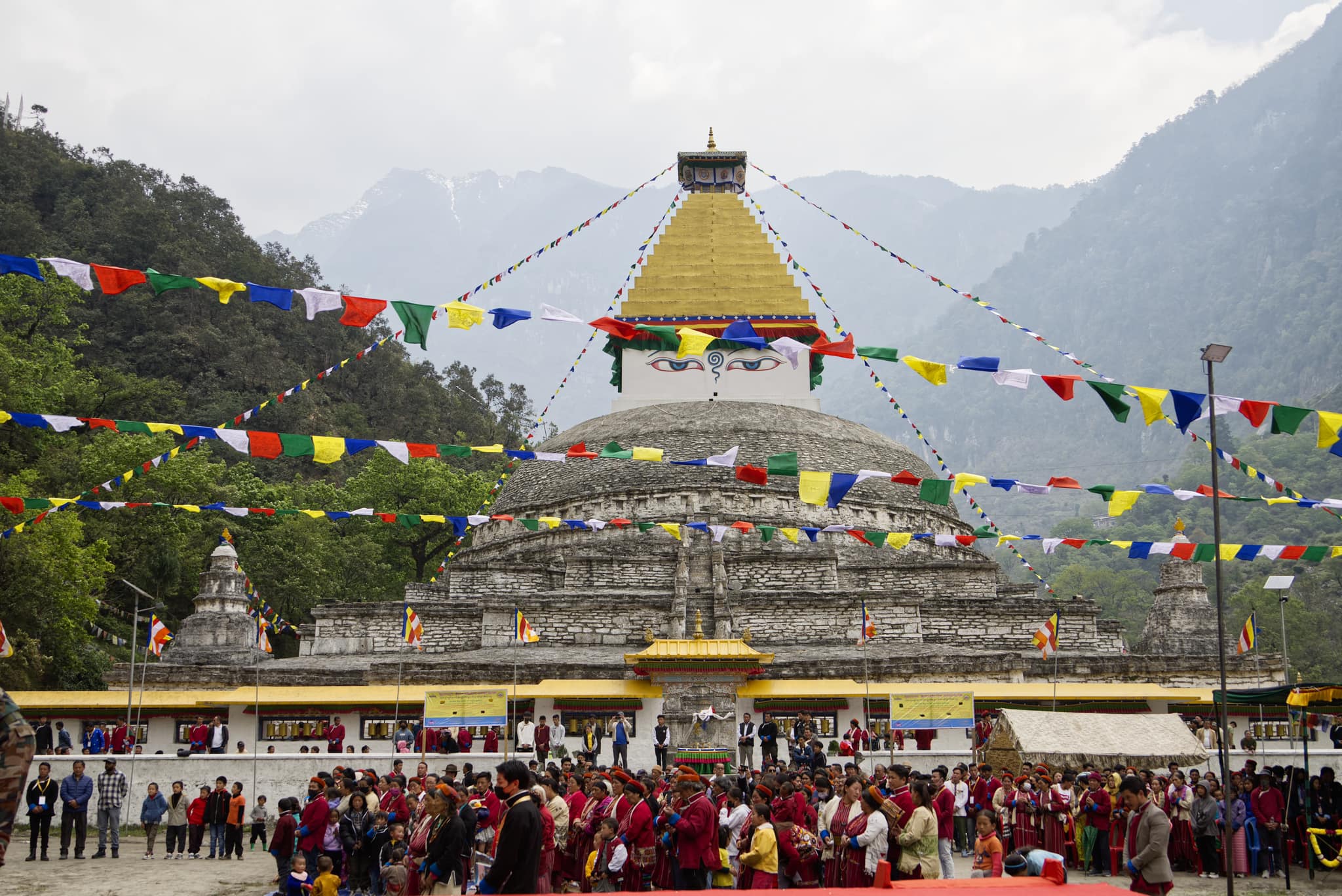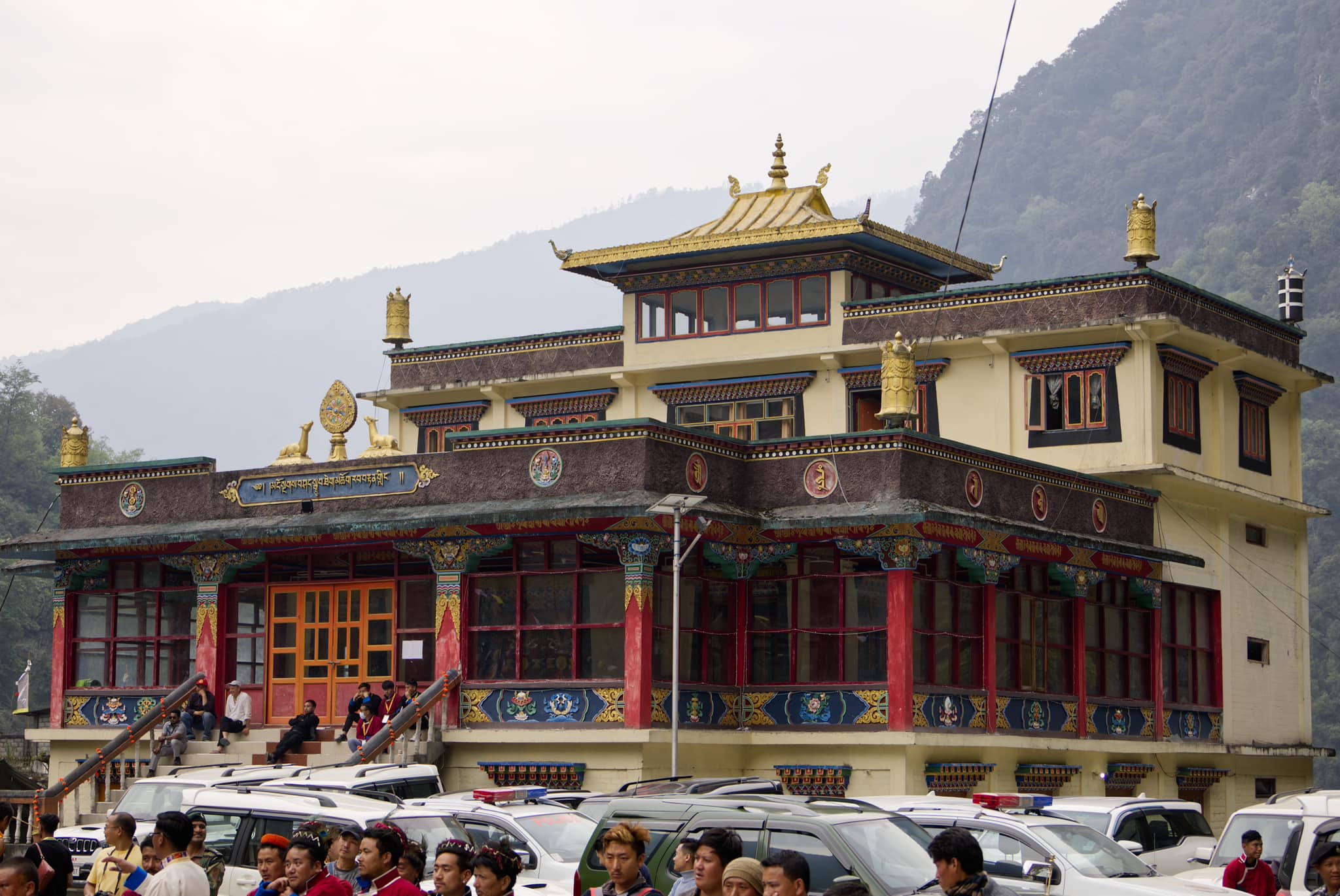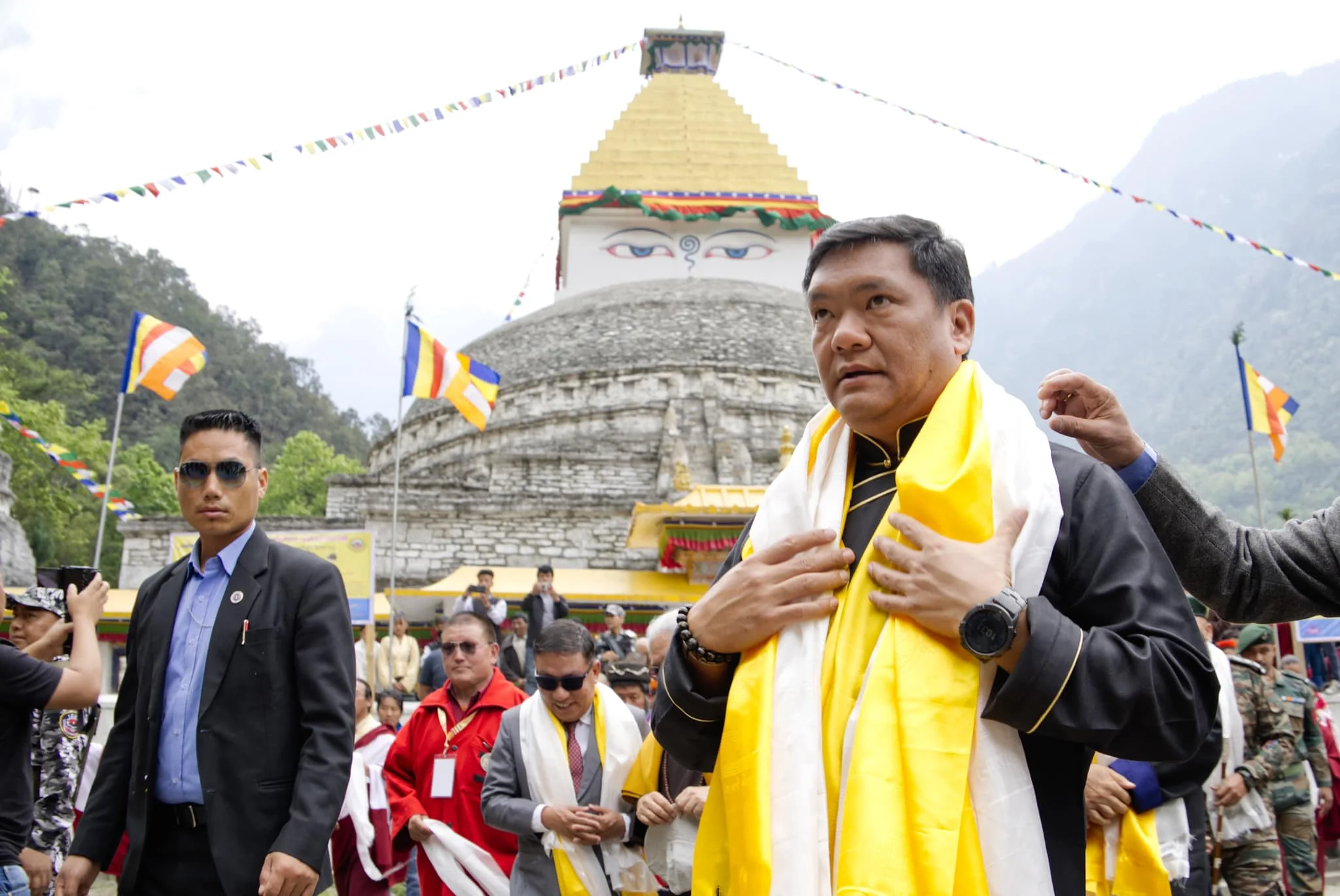The National Conference on Nalanda Buddhism: Re-tracing the Source in the Footsteps of Acharyas: from Nalanda to Himalayas and Beyond’ on 17th April, 2023 at GorsamStupa, Zemithang, Tawang, Arunachal Pradesh was organised by the Indian Himalayan Council of Nalanda Buddhist Traditions (IHCNBT). The National Conference was inaugurated by Chief Guest ShriPemaKhandu, Hon’ble Chief Minister, Arunachal Pradesh, in the Holy presence of H.E.T.K Lochen Rinpoche, H.E. PadmashreeThegstse Rinpoche, Tawang, A.P, H.E. Padmashree Guru Rinpoche, Bomdila, A.P., Khen Rinpoche, Tashiding Monastery, Sikkim, Geshe Lama ChosphelZotpa, President, HBCA, Delhi, H.E. Sangling Rinpoche, Dirang, A.P. and Guest of Honour Mn. UllasKulkarni, NE Chief, RSS, Guwahati, Mrs.TseringLhamu, Hon’ble MLA, Lumla, A.P., ShriTseringTashi, Hon’ble MLA, Tawang, A.P., Brig. VikasLal, ZemithangBde, ShriJambeyWangdi, Chairman, Dept. of Karmik&Adhyatmik Affairs, Govt. of A.P., ShriRinchinDorjee, Chairman, Information Commissioner,Govt. of A.P.,Dr.GurmetDorjey, Director, CIHCS Dahung, A.P.,ShriKesangNgurupDamo, Deputy Commissioner, Tawang, A.P. by lighting the lamp in front of GorsamChorten and Mangalacharan by Monks & Nuns by all Sangha Members.
After that observed 2 minutes of Silence in the memory of Late ShriJambeyTashi, Hon’ble MLA, Lumla, Late ShriThuptenTempa, Former Minister, and Late Shri Karma Wangchu, Former Minister Padma Shri (Posthumous) from MonyulTawang.
The Chief Guest, Guest of Honour and Dignitaries was felicitated with Momento and Khatak and released of the Souvenir for the National Conference on Nalanda Buddhism by the ShriPemaKhandu, Hon’ble Chief Minister, Govt. of Arunachal Pradesh and Other Dignitaries.
The National Conference was attended by delegates of revered Rinpoches, Geashes, Khenpos and scholars from all the Himalayan States of Himachal Pradesh, Ladakh (Union Territory), Uttrakhand, Jammu & Kashmir (Paddar-Pangi), Sikkim, North Bengal (Darjeeling, Doors, Jaigaon and Kalimpong), Densa South India Monasteries and various parts of Arunachal Pradesh like- Tuting, Mechuka, Tasking, Anini and others, that was 600 delegates & approx. 2500 public.
In his welcome speech, the General Secretary, ShriMalingGombu spoke on the importance of Buddhism and that Nalanda Buddhism that was the gift of India to the world. Today the Nalanda Buddhism is spreading far & wide. He spoke on the formation of IHCNBT with a National Conference on Buddhism in 21st Century on 29th& 30th June, 2018 at New Delhi (Gurugram) wherein for two days 300 Scholars, Social workers, Monks, Nuns & Rinpoche’s from Indian Himalayan region, wherein the formation of IHCNBT was founded. The delegation briefed HHDL on the issue and HHDL advised the delegation for the name IHCNBT and was very happy to develop the monasteries in the Himalayan region as centre of study/learning.
He spoke on the objectives of IHCNBT for development & preservation of Nalanda tradition of Buddhism and re-trace to Nalanda Masters for the Mahayana Buddhism is all of NalandaBuddhism that developed & went to the world over and once upon a time the entire Bharatvarsh influence by Buddhism like the times of SamratAshoka.
At the present time, In India today, Buddhism is on decline & there is need to strengthen the Monastic education system and develop relation belt lay people & the Monastic community. He also spoke on series of National Conference conducted all across Himalayan region.
In his keynote address, President, IHCNBT, Delhi, H.E. TK Lochen Rinpoche, extended deep gratitude to the IHCNBT for taking initiatives to addressthis crucial point through this conference.Sincepre-emptivestepsare much better solutions than remedies, Highlighting the significant growth in the literacy rate among Himalayan people in general and particularly among women of the Himalayan region, He stressed the need to revisit the old modes of propagation and practice of Dharma and search for new ways and methods more appropriate to contemporary people. He added that such conferences on Himalayan culture and religion will offer a platform for complete and thorough discussions, coupled with an in-depth understanding of the subject matter would help achieve common benefits for the Himalayan region and the wider world. He said that he would like to request that various Himalayan cultural and religious organizations existing in thepan-Himalayan region radiate and resonate similar spirit and enthusiasm to address the clear and presentdangerwearefacingnow. He said that a complete and thorough discussion grounded on sincerity, focus, and an in-depth understanding of the subject matter may help us produce good outcomes for the Himalayan region and wider world.Whateveroutcome we get from this and various other conferences on Himalayan culture and religion, we should share it openly for the common benefit of all.Since collective effort is a better approach than working independently to solve a widespread problem,we must create networks and link our efforts to mutually support each other. We are at a crossroads now, so the timing is crucial; missing this opportunity may causeus great regret in the future.
The Hon’ble Chief Minister, Arunachal Pradesh, ShriPemaKhandu said the Buddhist culture, which thrives on the peaceful co-existence of every sentient being, should not only be preserved but also propagated. ShriKhandu said the state has a big chunk of the Buddhist population and “fortunately they have kept their culture and traditions safe with religious fevour”. The main pillar on which Nalanda Buddhism stands is the principle of ‘reasoning and analysis’. This means we can even bring the teachings of Lord Buddha under the ambit of reasoning and analysis. This logic is based on science and perhaps Buddhism is the only religion that gives its followers this liberty.
He said that Arunachal Pradesh is not home only to Buddhism but to several religions, including those who follow their own indigenous faith. I believe that every religion and faith should flourish and exist peacefully. I am proud that we Arunachalis are doing just that. He expressed gratitude to the Indian Himalayan Council of Nalanda Buddhist Tradition (IHCNBT) for organising the National Conference on Nalanda Buddhist Tradition on retracing the source in the footsteps of Acharyas: “from Naland to Himalaya and beyond”. He said that Zemithang, as you might all know, is the last Indian border through which His Holiness the 14th Dalai Lama entered India in 1959. Therefore, holding this conference here is significant. While nothing that Buddhism was expanding globally and witnessing an important resurgence in few traditional areas, ShriKhandu pushed for the need to make its presence more vibrant with roots connected to Nalanda Buddhism. He insisted that those attending the conference, especially the youth, stay put for the three technical sessions scheduled for the day. We are blessed to receive his teaching based on ancient Nalanda Tradition,” he said. He added that great scholars of Nalanda University had developed Nalanda Buddhist Traditions and with time they went to Tibet and propagated the faith through the great Nalanda gurus such as AcharyaSantarakshita and Nagarjuna, among others. Hon’ble Chief Minister ShriPemaKhandu expressed his support through the Department of ofKarmik and
Adhyatmik for such activities and also announced of Corpus fund a sum of Rupees Three crores to the Indian Himalayan Council of Nalanda Buddhist Tradition (IHCNBT) to continue its activities that seek to preserve, promote and strengthen cultural and philosophical heritage across the Buddhist Himalayas. He also mentioned how Arunachal Pradesh is the land of the rising sun among the Indian States, where the rays of dawn illuminate the sky first; likewise, the state can be a leading light for other states in India in implementing policies of socio-cultural and environmental impact.
The conference also featured in-Three depth sessions on ‘Nalanda Buddhism: In the Footsteps of Nalanda Masters, ‘Nalanda Buddhism: In the Footsteps of Guru Padmasambhava in the Himalayas and Nalanda Buddhism in 21st Century: Challenges & Response conducted by esteemed scholars and guests. The three Scholastic Sessions that followed the inauguration ceremony were a vibrant discussion of ideas spanning generations of ancient Indian Nalanda Scholars, Himalayan Yogis and Tibetan Buddhist Masters. The historical legacy of the great NalandaMahavihara and its impact on Indian Logical, Epistemological, Metaphysical and Ethical systems of throught was elaborated and the contribution of its eminent acharyas like Nagarjuna, Aryadeva, Vasubandhu, Dignara, Chandrakirti, shantideva, Shantarakshita, Kamalashila, Dharmakirti, Gunaprabha, Asanga and their notable works were discussed. These lofty yet pragmatic ideas from Nalanda would eventually be incorporated into the Tibetan kingdom and way of life under the patronage of the influential Tibetan King TrisongDetsen, Which over time, would organically evolve into different schools of Buddhist thought such as Nyingma, Kagyu, Sakya and Gelug without compromising the essence of Buddha’s teachings and each school individually maintained an authentic historical link to Nalanda in its genealogy. So long after the pillaging and wanton destruction of the Nalanda site by BakhtiyarKhilji in the 12th century, the light of the Nalanda lamp would continue to illuminate the Himalayas from Tibet.
Guru Padmasambhava - a Himalayan Yogi whose spectacular life and profound teaching legacy continue to impact Tibet, Ladakh, Sikkim, Nepal, Bhutan, Monyul and Himachal regions was also recounted in a session. If the mastery of scriptural doctrine was the skill to be acquired in the monasteries, the deep meditative self-awareness and oneness to be experienced in the chaos of pristine nature was the path of the wandering yogi. Thereby making both the study of scriptures and the informed practice of rituals equally important for awakening. Guru Padmasambhava’s extraordinary life and teachings, like that of the Mahasiddhas of India, would later become a template for many Tibetan Yogis and mystics like Milarepa, and LotsawaRinchenZangpo.
The First session was on “Nalanda Buddhism-In the Footsteps of Nalanda Masters” chaired by H.E.T.K LochenTulku Rinpoche & co-chaired by H.E. Padma Shri Guru Rinpoche, Bomdila.
The speakers on the session were Er. ThuptenKalden, Buddhist Scholar, Tawang, Arunachal Pradesh, Ven. DondupTsering, Khen Rinpoche, GontseRabgyaling Monastery, Bomdila, Dr.TsewangGyatsoBhutia, Asst. Prof. Namchi College, Sikkim, Tulku Karma Gyaltsen, TutingNgesangDongakJangchubDarjelling Monastery and ShriYountenPhutsokChader, Tasking, Arunachal Pradesh.
The Second session was on “Nalanda Buddhism-In the Footsteps of Guru Padmasambhava-Himalayas” chaired by H.E. Padma ShriThegtse Rinpoche, Abbot, Khinmey Monastery, Tawang and co-chaired by H.E. Padma Shri Guru Rinpoche, Bomdila.
The speakers on the session were Dr.RigzenGurmet, Asst. Prof. Arunachal University, Namsai, Arunachal Pradesh, KhenpoJigmeLodoe, Khampagar Monastery, Tashijong, Himachal Pradesh, GesheNawang, Tawang Monastery, Arunachal Pradesh, SeyDawaDorjeeNaksang, Menchuka, Arunachal Pradesh and TulkuDongagLeksheGyatso, Zayul, Arunachal Pradesh.
And the Third session was on “Nalanda Buddhism in 21st Century: Challenges & Response” chaired by Ven. Khen Rinpoche, Abbot, Tashiding Monastery, Sikkim and co-chaired by ShriMalingGombu, General Secretary, IHCNBT, Delhi.
The speakers on the session were Dr.GurmetDorjey, Director, CIHCS, Dahung, Arunachal Pradesh, Geshema Tenzin Lhadron, Nunnery, Dharamshala, Himachal Pradesh, Mrs. Lama NeeraLopchen, Advisor, Tamang Development Board, Kalimpong and Dr.HisseyWangchukBhutia, Research Officer cum Asst. Director, Dept. of Ecclesiastical, Govt. of Sikkim.
The National Conference at GorsamStupa, Zemithang was a grand success attended by around 3000 peoples in remote border region despite having lot of logistics challenges. The conference was also widely covered by print media, social media and National News Channels.
The take away points from National Conference on Nalanda Buddhism: Re-tracing the Source in the Footsteps of Acharyas: from Nalanda to Himalayas and Beyond at Gorsamwere:
1. The ancient 12th century GorsamStupa built by Lama sangeyPrathar got highlighted as living Buddhist Heritage.
2. The border town of Zemithang is which His Holiness Dalai Lama stayed for 2nd night in 1959 after entering India got highlighted.
3. The Nalanda Buddhism as origin from India got highlighted.
4. For the first time many revered & highly reputed Rinpoches, Geshes, Khenpos of Nalanda Tradition and Scholars from all Himalayan States & from all parts of Arunachal Pradesh came together in presence of Hon’ble Chief Minister ShriPemaKhandu& Others dignitaries at Zemithang Conference and deliberated upon Nalanda Buddhism in 21st Century.
5. That it was highlighting of Mahayana Buddhism as Nalanda Buddhism that is from India as origin and that it is practiced & followed in entire Himalayan belt of India bordering with Tibet (China).
6. That, the sectarian divide amongst Nyingma, Geluk, Kagyu &Sakya was nullified and it was declared as NalandaBudhism without stressing on tradition/sectarian differences.
7. That, the narrative of Nalanda Buddhism from Nalanda as roots & origin- Nalanda Buddhism was promoted & propagated.
8. That the Buddhism from India is Nalanda Buddhism-tracing to the roots-NalandaAcharyas.


